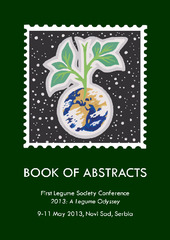| dc.creator | Mikić, Aleksandar | |
| dc.date.accessioned | 2022-08-12T10:18:51Z | |
| dc.date.available | 2022-08-12T10:18:51Z | |
| dc.date.issued | 2013 | |
| dc.identifier.isbn | 978-86-80417-44-8 | |
| dc.identifier.uri | http://fiver.ifvcns.rs/handle/123456789/3029 | |
| dc.description.abstract | Apart from their prominent roles as food and feed, legumes have numerous forms of non-food uses, with green manure and biofuel as the most widely present in agriculture and industry. Most legume species are easily recognised for the colour of their flowers and it is rather natural there are legumes cultivated especially for ornamental purposes. One of the most renown decorative legume species is sweet pea (Lathyrus odoratus L.), an annual with great diversity of flower size and petal shape. Breeding sweet pea has a tradition long more than a century, especially in UK, resulting in developing a large number of sweet pea cultivars of diverse flower colour, size and shape and fragrance length and intensity. The largest collection of sweet pea in the world was established and is maintained by Roger Parsons, gaining a status of a UK national collection and comprising about 900 cultivars of sweet pea and around 100 taxa of other Lathyrus species. Garden lupin (Lupinus polyphyllus Lindl.) is a perennial herbaceous species native to North America. The most significant efforts in breeding garden lupin were made by George Russell from UK, developing an ideotype present in majority of the contemporary cultivars. There are other ornamental lupin species, such as Texas Bluebonnet (Lupinus texensis Hook.), the favourite of many Texans and one of the state flowers of Texas. Among the woody perennial legumes, grown as ornamentals, it is noteworthy to mention Japanese wisteria (Wisteria floribunda (Willd.) DC.), a liana species, as well as deciduous trees, such as Judas tree (Cercis siliquastrum L.), honey locust (Gleditsia triacanthos L.), golden-chaintree (Laburnum×watereri (G. Kirchn.) Dippel) and Pagoda Tree (Styphnolobium japonicum (L.) Schott). | sr |
| dc.language.iso | en | sr |
| dc.publisher | International Legume Society | sr |
| dc.publisher | Novi Sad : Institute of Field and Vegetable Crops | sr |
| dc.relation | info:eu-repo/grantAgreement/MESTD/Technological Development (TD or TR)/31024/RS// | sr |
| dc.rights | openAccess | sr |
| dc.rights.uri | https://creativecommons.org/licenses/by/4.0/ | |
| dc.source | Book of Abstracts, 1st Legume Society Conference 2013: A Legume Odyssey, 9-11 May 2013, Novi Sad | sr |
| dc.subject | legumes | sr |
| dc.subject | species | sr |
| dc.subject | decorative plants | sr |
| dc.subject | collections | sr |
| dc.subject | sweet pea | sr |
| dc.subject | ornamental species | sr |
| dc.subject | garden lupin | sr |
| dc.title | All legumes are beautiful, but some legumes are more beautiful than others | sr |
| dc.type | conferenceObject | sr |
| dc.rights.license | BY | sr |
| dc.citation.epage | 232 | |
| dc.citation.spage | 232 | |
| dc.identifier.fulltext | http://fiver.ifvcns.rs/bitstream/id/8442/233.pdf | |
| dc.identifier.rcub | https://hdl.handle.net/21.15107/rcub_fiver_3029 | |
| dc.type.version | publishedVersion | sr |


